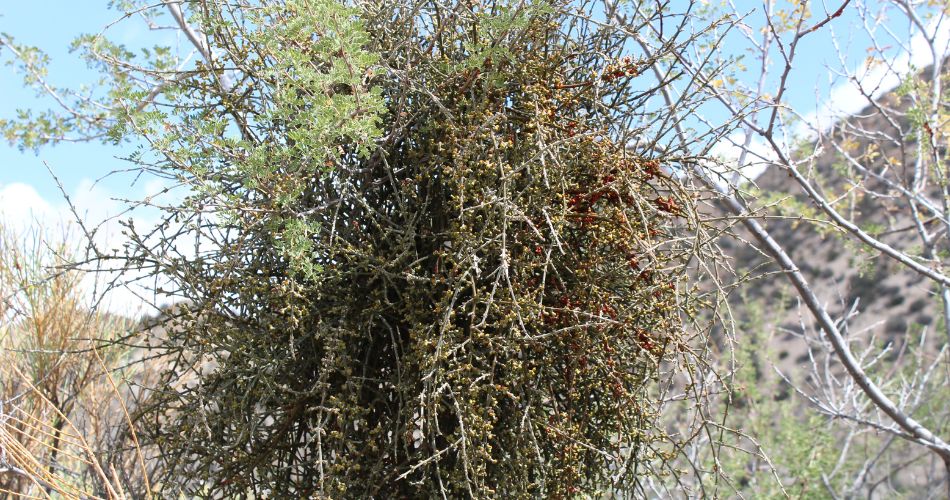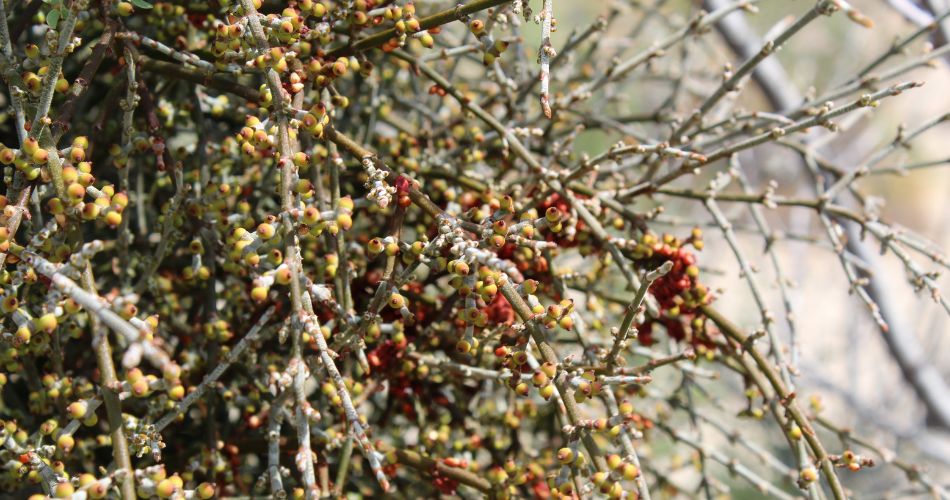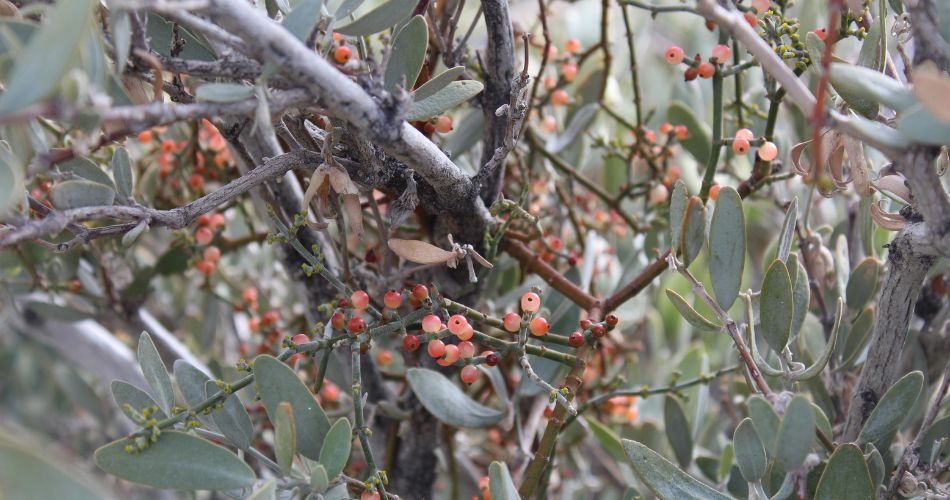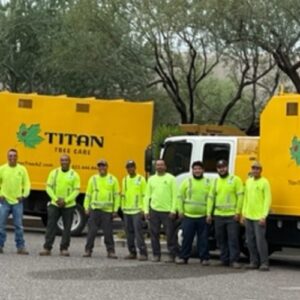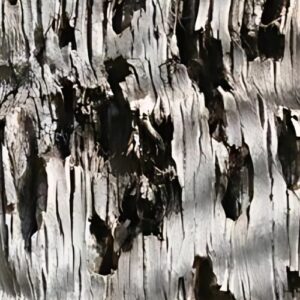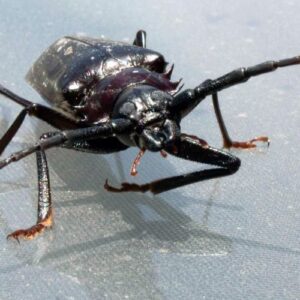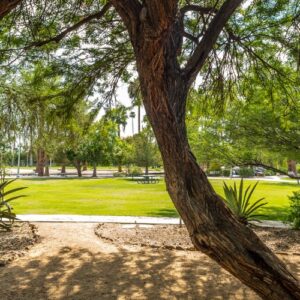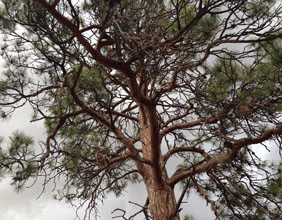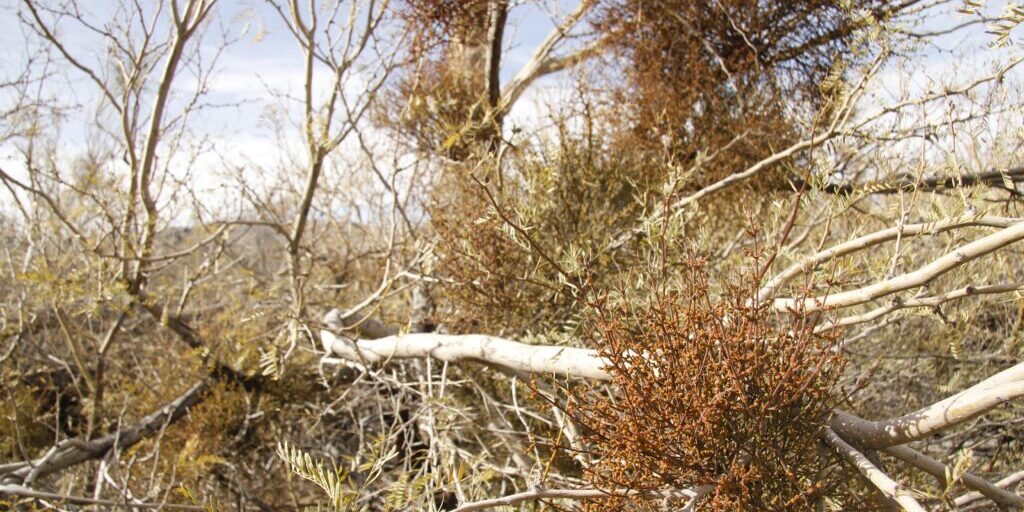
If you’ve ever noticed a cluster of what appear to be twigs or small branches concentrated together in your mesquite or palo verde tree, it may in fact be desert mistletoe. Mistletoe is often confused for a nest or hive, but it is a living, growing organism.
In this article, we will cover:
- What desert mistletoe is
- How desert mistletoe spreads
- How to tell if desert mistletoe might kill your tree
- Which trees in the Phoenix and Anthem areas are most likely to host desert mistletoe
- How to decide if you should have desert mistletoe removed from your trees
- How desert mistletoe is removed
- And when you should call Titan Tree Care for assistance with your desert mistletoe
Keep reading to learn more about this unique desert hemiparasite.
What is desert mistletoe?
Desert or mesquite mistletoe (Phoradendron californicum) is a hemiparasite that affects many of our local trees. It doesn’t look quite like the traditional mistletoe hung in doorways during the holidays, but that’s because it’s a different variety. There are over 1,000 distinct species of mistletoe worldwide.
The scientific classification of mistletoe, Phoradendron, translates to “thief of a tree,” which is a good way to think about mistletoe. It’s not “death of a tree,” per se, but it does rob your tree of certain things.
As a hemiparasite, desert mistletoe attaches itself to a tree and steals water and nutrients from it. It doesn’t grow leaves, but the green stems of mistletoe photosynthesize, using the sun to generate food and nutrients as well.
How does desert mistletoe spread?
After the mistletoe has been on a tree for a few years, it will start producing small, reddish-orange berries. The berries are incredibly sticky and often adhere to the feet of birds that eat the berries. This is how mistletoe is often spread to nearby trees – when a bird lands on another tree’s branch, the mistletoe attaches itself to that tree and eventually begins growing there.
Will desert mistletoe kill your tree?
Despite popular belief, desert mistletoe is highly unlikely to kill your tree. As a hemiparasite, it depends on the tree for its survival. If the tree dies, the mistletoe will also die. So, from a biological standpoint, it’s in the mistletoe’s best interests to keep the host tree alive. In fact, some mistletoe can live on trees for upwards of 70 years!
There are very few instances of desert mistletoe being the sole cause of death for a tree. When it does contribute significantly to a tree’s death, it’s usually because there are multiple large clusters of mistletoe on the same tree and/or the tree is already weakened from a disease, pest, or lack of water.
What trees are host plants for desert mistletoe?
Check for desert mistletoe in these trees and shrubs:
- Mesquite
- Palo verde
- Ironwood
- Acacia
- Creosote bush
- Desert buckthorn shrubs
Desrt mistletoe is more common the closer you are to the natural desert, where it often grows unchecked.
Should I remove desert mistletoe from my tree?
There’s a debate about whether desert mistletoe should be removed from trees.
Some choose to remove mistletoe for aesthetic purposes, others wish to slow its spread (some neighbors, for instance, may not be happy if a bird brings mistletoe to their trees from yours).
On the other hand, the berries are an important food source for birds in our area, and removing large clusters of desert mistletoe can seriously damage the appearance, stability and/or health of a tree if too many large branches are removed. In some cases, it may be better to remove a heavily infested tree entirely rather than cutting out the mistletoe.
Overall, the recommendation is to remove desert mistletoe from urban and suburban areas to stop its spread, but to let it grow in the wild. After all, it is a normal part of desert life and has cohabitated with our desert trees for years and years.
How is desert mistletoe removed?
The earlier you spot desert mistletoe in your trees, the better. Look for an unusual cluster of “branches” that form almost in the shape of a sphere.
It’s much easier to spot mistletoe during the winter months, once trees have lost their leaves. Mistletoe stands out with its bright green color amongst the bare branches.
At Titan Tree, we usually remove the infected area of the tree by carefully pruning out the mistletoe and any branches it has attached itself to. If you choose to prune out the mistletoe yourself, be careful not to remove too many branches, as this will cause undue stress to the tree (similar to when a tree is topped). It’s also important to make proper pruning cuts (to avoid inviting pests and disease pathogens to attack the tree) and ensure you take safety precautions, especially if the mistletoe cannot be reached from the ground.
If you can easily reach it, you can brush young mistletoe off (usually using just your hands), but this does not remove the mistletoe forever – it will continue growing back, so you will have to continue removing it.
Healthy trees are less prone to infestation as they can fight off the mistletoe, so keeping your trees healthy and checking for unusual growth can prevent its spread.
Contact Titan Tree Care for Desert Mistletoe Services
Not sure if your trees have desert mistletoe? Unsure whether the desert mistletoe in your tree can be safely removed without damaging the tree? Contact Titan Tree Care to schedule a consultation. We’ll recommend the best course of action to keep your tree healthy and looking its best.
More Articles Like This

Titan Tree Care is a full-service tree care company located in Anthem, AZ and serving all of North Phoenix. We offer a wide range of services to meet your tree care needs, including tree and palm trimming, tree pruning, tree removal, stump grinding, and more. We also offer insect or disease treatments and fertilization services. We are dedicated to providing high-quality, safe, and effective tree care services to our customers and work hard to ensure that your trees are healthy and look their best.



